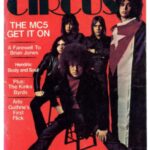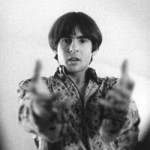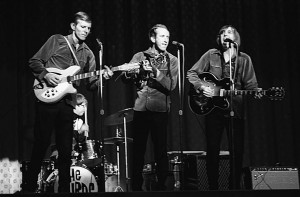-
Featured News
The MC5: A Eulogy
 By Doug Sheppard
And then there were none. Five equals zero. The morning of May 9, 2024, the last surviving member of the MC5, drummer Dennis Thompson, died while recovering from a heart attack—
By Doug Sheppard
And then there were none. Five equals zero. The morning of May 9, 2024, the last surviving member of the MC5, drummer Dennis Thompson, died while recovering from a heart attack— -
Featured Articles
The Beatles: Their Hollywood and Los Angeles Connection
 By Harvey Kubernik
JUST RELEASED are two new installments of the Beatles’ recorded history, revised editions of two compilation albums often seen as the definitive introduction to their work.
Or
By Harvey Kubernik
JUST RELEASED are two new installments of the Beatles’ recorded history, revised editions of two compilation albums often seen as the definitive introduction to their work.
Or -
Davy Jones 1945-2012

David Thomas “The Manchester Cowboy” Jones’ first love was jockeying, a fitting choice for the height-challenged heartthrob, until the stage called him. A later American promo tour for Oliver! fated him with the divinity to appear on the Ed Sullivan Show the monumental date of February 9, 1964. From side-stage a teenaged Jones was bewitched by the Beatles making their American debut and found truly what pie he was a piece of.
Of the Monkees remarked Davy they were a “good garage band,” and perhaps that’s what endears them to UT readers, even those not hip to poppin’ bubblegum. While some of the Prefab Four later divorced themselves from the entity due to its synthetic, machine-made product value, Jones trudged along living and singing the hell out of those hits until he tragically left us. Those inescapable jams of childhood made me a believer, and I shall be to until the day I expire. Godspeed, King of the Wild Tambourine.
Below Michael Lynch pours his Monkee-lovin’ heart out, and a playlist to partake in compiled from Michael’s references and a few of my own. (jeremy nobody, esq.)
The short Monkee. The English Monkee. The cute Monkee. The one who got the girls. The one who played tambourine. The one who later called on Marcia Brady. However people remember Davy Jones, the point is, everybody will remember him.
An all-around entertainer, Davy already had racked up some success as an actor before Screen Gems made a Monkee out of him, most notably his Tony-nominated portrayal of the Artful Dodger in the Broadway production of Oliver! The success of Oliver! led him to try milking his teen appeal through American television guest spots (Ben Casey and Farmer’s Daughter) and, of course, records. 1965 yielded an album, David Jones, and three singles for Colpix, only one of which (“What Are We Going to Do”) charted, and at only #93. His luck changed that autumn when he was chosen as one of the stars of an impending sitcom about “four insane boys.”
Pete Cosey 1943-2012
By Eric Colin Reidelberger
Few guitarists are more underappreciated than the big man, Pete Cosey. An incomparable aural trailblazer and avid woodshedder who blew the doors off every entrance he made. As a wide-open player who employed many musical “systems” (as he called them) he preferred bridges to barriers and played with jazz, country, frat rock and blues bands alike, when that practice was purely unheard. He was a session man, manipulator of chord progressions and such a wild experimentalist that Miles Davis once told him that he “…wrote differently than anyone he’d heard.” It’s with hope that there are more extant sides to arrive from this mountain of a man, both physically and as an institution. Below Sir Eric Colin gives lip service to the man’s history and prowess, plus I’ve included a playlist of some of Cosey’s contributions. What’s your fave-rave? (jeremy nobody, esq.)
Pete Cosey’s name might not have been at the tip of everyone’s tongue, but if you owned any records on the Chess label from the late ’60s or dug your heels into any of Miles Davis’ grand wigouts, then chances are you are probably familiar with his handiwork. A sonic adventurer that boldly went where only a few dare tread, finding the continuity between Jazz, Funk and Psychedelic Rock and trailblazing his own pathway to the nether regions.
Born in Chicago, Illinois, in 1943 and after living his teenage years in Phoenix, Arizona, Pete cut his teeth as a session player in the ’60s/early ’70s back in Chicago for Chess Records. He played on numerous sessions (often uncredited) by artists such as Etta James, Chuck Berry, Gene Ammons, Sonny Stitt, Rotary Connection and the polarized electric periods of both Howlin’ Wolf and Muddy Waters. Adding a surfeit of effects, including a wonderful preponderance of wah-wah/fuzz acrobatics, Pete managed to completely horrify blues purists in one fell swoop, and gather quite an audience of heads who would go on to champion his bold explorations in the years to come.
Cosey was a truly inventive and original player who was obviously influenced by Hendrix’s stylings, but taking the proceedings into an almost unhinged free jazz territory akin to similar giant steps taken by fellow traveler Sonny Sharrock. He was an embryonic member of Chicago Afro Funk behemoths The Pharoahs who later became the seeds of Earth, Wind & Fire, as well as exploring some spiritual journeys with Philip Cohran. Pete is best remembered for the four albums he played on under Miles Davis’ solid-band leading hand: Get Up With It, Pangea, Agharta and Dark Magus.
It is here and in such stellar company that his creative being was given the proper chance to flourish; often pushing the music (and perhaps) the musicians into fever pitch territory.
After the breakup of the Miles band in 1975, Pete kept a relatively low profile, only rearing his head here and there in the years afterwards, most notably playing on the title track to Herbie Hancock’s Future Shock. On May 30, 2012 in Chicago, after complications with surgery, the world lost yet another major musical talent who really wasn’t given the proper credit of the true sonic pioneer he was.
From our current issue, Ugly Things #33, jeremy nobody, esq. reviews one of the grand experiments Cosey contributed to: This Is Howlin’ Wolf’s New Album: https://ugly-things.com/reviews/albums/
Doug Dillard
By Domenic Priore
Born to a musical family March 6, 1937 in the Ozark Mountains of Salem, MO, Doug Dillard counted Earl Scruggs as an early supporter. After initial encouragement via postal service the bluegrass legend later installed the tuners to Doug’s very first banjo with his own two hands, after a 500 mile trek by Dillard to the legend’s home with heckled parents in tow. Dillard, a forefather in his own right, was one of the early alchemists—with his group the Dillards—to fuse the soul of rock’n’roll to bluegrass and country music, bringing that peculiar hill-folk music to a ’60s youth generation. He brought down electricity on high from the sky and few have harnessed that instrument before or since with such power, dexterity and skill. Doug left this square world on May 16, 2012, aged 75, in Nashville, TN, of lung infection brought on from a collapsed lung a few months prior. Below our pal Domenic Priore issues the raw facts on the legend. (jeremy nobody esq)
Banjo picker Doug Dillard came out to Los Angeles from his native Missouri with his brother Rodney, Dean Webb and Mitchell Jayne as the Dillards, and quickly helped to popularize bluegrass music as part of the LA Folk scene during the early ’60s at clubs like The Ash Grove, The Troubadour, The Ice House, The Mecca, The Golden Bear and others that made the city a freeway spread-out Greenwich Village of the West Coast. The Dillards were surrounded by a lot of great local bluegrass talent that would evolve into The Byrds ever-growing family tree: the Country Boys/Kentucky Colonels (with Clarence White), the Scottsville Squirrel Barkers and the Golden State Boys (both featured Chris Hillman, the latter featured Chris with Vern and Rex Gosdin). The Dillards were managed by Jim Dickson who would also come to manage the Byrds. When the Dillards made the attempt to electrify in 1965, Jim hired Dewey Martin prior to his taking the drummer spot in Buffalo Springfield. This kind of interaction would play an incredible part in the growth of early Country Rock from its most core hill-bound element.
